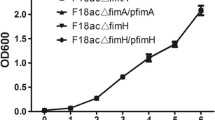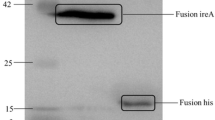Abstract
Lactoferrin (Lf) is an iron-binding protein which plays an important role in the host defense systems of different mucosal surfaces including the intestinal mucosa. In the present research the role of apo-Lf and iron-saturated Lf in the invasion process of enteroinvasive bacteria, grown in iron stress or excess, was investigated. As enteroinvasive bacterium, Eschericha coli HB101 strain harboring a plasmid which contains the chromosomal inv gene from Yersinia pseudotuberculosis was utilized. The product of this gene (invasin) enables this microorganism to invade human epithelial cultured cells (HeLa). The results obtained showed that apo-Lf and iron-saturated Lf added at physiological concentration during the infection exerted a significant inhibition of adhesion (3.2 × 105 instead 3.4 × 106 adherent bacteria grown in iron excess; 1.6 × 103 instead of 2.3 × 104 adherent bacteria grown in iron-limited medium) and internalization (4.0 × 105 instead of 3.7 × 106 internalized bacteria grown in iron excess; 2.1 × 103 instead 2.8 × 104 internalized bacteria grown in iron-limited medium). It has also been demonstrated that in these experimental conditions Lf binds to HeLa cell membrane as well as to bacterial outer membrane. It is likely that this binding interfere with the early events of interaction between bacteria and eukaryotic cells. This inhibiting effect of Lf on the invasion efficiency of E. coli HB101(pRI203) could be related to the cationic nature of the molecule, although other mechanisms cannot be ruled out.
Similar content being viewed by others

References
Arnold RR, Cole MF, McGhee JR (1977) A bactericidal effect for human lactoferrin. Science 197:263–265
Arnold RR, Brewer M, Gauthier JJ (1980) Bactericidal activity of human lactoferrin: sensitivity of a variety of microorganisms. Infect Immun 28:893–898
Baldwin DA, Jenny RE, Aisen P (1984) The effect of human serum transferrin and milk lactoferrin on hydroxyl radical formation from superoxide and hydrogen peroxide. J Biol Chem 259:13391–13394
Bezwoda WR, Mansoor N (1989) Lactoferrin from human breast milk and from neutrophil granulocytes. Comparative studies of isolation, quantitation, characterization and iron binding properties Biomed Chromatogr. 3:121–126
Britton JR, Koldovsky O (1989) Gastric luminal digestion of lactoferrin and transferrin by preterm infants. Early Hum Dev 19:127–135
Brock JH (1980) Lactoferrin in human milk: its role in iron absorption and protection against enteric infection in the newborn infant. Arch Dis Child 55:417–421
Campbell EJ (1982) Human leukocyte elastase, cathepsin G, and lactoferrin: family of neutrophil granule glycoproteins that bind to an alveolar macrophage receptor. Proc Natl Acad Sci USA 79:6941–6945
Conte MP, Mastromarino P, Nicoletti M, Visca P, Valenti P, Seganti L (1990) Effect of polyelectrolytes on entry of Escherichia coli HB101(pRI203) into HeLa cells. Microb Pathol 9:191–198
Conte MP, Longhi C, Buonfiglio V, Polidoro M, Seganti L, Valenti P (1993) Different invasion ability of E. coli HB101(pRI203) grown in iron-excess or in iron-limiting conditions. J Med Microbiol (in press)
Dalmastri C, Valenti P, Visca P, Vittorioso P, Orsi N (1988) Enhanced antimicrobial activity of lactoferrin by binding to the bacterial surface. Microbiologica 11:225–230
Davidson LA, Lonnerdal B (1988) Specific binding of lactoferrin to brush-border membrane: ontogeny and effect of glycan chain. Am J Phisiol 254:580–585
Dennis Chasteen N, Woodworth RC (1990) Transferrin and lactoferrin. In: Prem Ponk H, Shulman M, Woodworth RC (eds) Iron transport and storage. CRC Press, Boston pp 67–69
Ellison RT III, Giehl TJ, LaForce FM (1988) Damage of the outer membrane of enteric gramnegative bacteria by lactoferrin and transferrin. Infect Immun 56:2774–2781
Ellison RT III, Giehl TJ (1991) Killing of gram-negative bacteria by lactoferrin and lysozyme. J Clin Invest 88:1080–1091
Gahr M, Speer CP, Damerau B, Sawatzki G (1991) Influence of lactoferrin on the function of human polimorphonuclear leukocytes and monocytes. J Leukoc Biol 49:427–433
Hu WL, Mazurier J, Sawatzki G, Montreul J, Spik G (1988) Lactoferrin receptor of mouse small-intestinal brush border. Biochem J 249:435–441
Isberg RR (1990) Pathways for the penetration of enteroinvasive Yersinia into mammalian cells. Mol Biol Med 7:73–82
Isberg RR, Falkow S (1985) A single genetic locus encoded by Yersinia pseudotuberculosis permits invasion of cultured animals cells by Escherichia coli K-12. Nature 317:262–264
Isberg RR, Voorhis DL, Falkow S (1987) Identification of invasin: a protein that allows enteric bacteria to penetrate cultured mammalian cells. Cell 50:769–778
Laemmli UK (1970) Cleavage of structural proteins during the assembly of the head of bacteriophage T4. Nature 227:680–685
Leong JM, Fournier RS, Isberg RR (1990) Identification of the integrin binding domain of the Yersinia pseudotuberculosis invasin protein. EMBO J 9:1979–1989
Mazurier J, Montreuil J, Spik G (1985) Visualization of lactotransferrin brush-border receptors by ligand-blotting. Biochim Biophys Acta 821:453–460
Miyazawa K, Mantel C, Lu L, Morrison DC, Broxmeyer HE (1991) Lactoferrin-lipopolysaccharide interactions. Effect on lactoferrin binding to monocyte/macrophage differentiated HL-60 cells. J Immunol 146:723–729
Moguilevsky N, Retegui LA, Masson PL (1985) Comparison of human lactoferrins from milk and neutrophilic leucocytes. Biochem J 229:353–359
Roiron D, Amouric M, Marvaldi J, Figarella C (1989) Lactoferrin-binding sites at the surface of HT29-D4 cells. Eur J Biochem 186:367–373
Tedeschi A, Tuccari G; Magazù G, Arena F, Ricciardi R, Barresi G (1987) Immunohistochemical localization of lactoferrin in duodenojejunal mucosa from celiac children. J Pediatr Gastroenterol Nutr 6:328–334
Valenti P, Visca P, Antonini G, Orsi N, Antonini E (1987) The effect of saturation with Zn2+ and other metal ions on the antibacterial activity of ovotransferrin. Med Microbiol Immunol 176:123–130
Visca P, Dalmastri C, Verzili D, Antonini G, Chiancone E, Valenti P (1990) Interaction of lactoferrin with E. coli cells and correlation with antibacterial activity. Med Microbiol Immunol 179:323–333
Author information
Authors and Affiliations
Rights and permissions
About this article
Cite this article
Longhi, C., Conte, M.P., Seganti, L. et al. Influence of lactoferrin on the entry process of Escherichia coli HB101(pRI203) in HeLa cells. Med Microbiol Immunol 182, 25–35 (1993). https://doi.org/10.1007/BF00195948
Received:
Issue Date:
DOI: https://doi.org/10.1007/BF00195948



